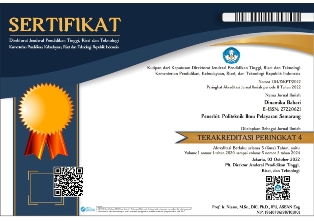Description of Emotion Regulation and Attachment Patterns of Cadets at Boarding Maritime Colleges
Abstract
Boarding universities require students to follow the existing rules quite strictly, starting from waking up in the morning until going back to sleep. Students who live in dormitories must immediately adjust even though it feels difficult. The demands of the new environment must be responded to wisely. Individuals who have a tough personality will be able to adapt to the demands of a new environment wisely. This research aims to look more closely at the emotional regulation of students who live in dormitories in terms of the attachment patterns they develop before becoming students and during their time as students. This research uses descriptive qualitative research methods, trying to explore the description of students' emotional regulation during life in the dormitory and the impacts that arise. The results of this research reveal that there are four types of attachment patterns with different self-regulation, namely secure, bound, inbound and anxious attachment patterns. The conclusion from the results of this research is that a secure attachment pattern will give rise to positive emotional regulation. Positive emotional regulation needs to be developed so that students are able to undergo education while in the dormitory with excellent mental health, are able to adapt to their social environment well, are more productive and in the future these individuals will be able to face challenges in their lives better. This research continues research expressed by Fitri (2023), namely that the stressors most often experienced by students living in dormitories are intrapersonal stressors at 62.59%. Without mature intrapersonal abilities, it will be difficult for individuals to face the unexpected and establish good relationships with other people
Downloads
References
Bowlby, R. (2008). Attachment, What it is, Why it is Important and What We Can Do About it to Help Young Children Acquire A Secure Attachment. Edition 2. Foreword By Allan N. Schore. London : Basic Book.
Coon, D. (2005). Psychology a Journey (2nd ed.). USA : Thomson Wadsworth.
Desmita. (2009). Psikologi Perkembangan Peserta Didik. Bandung : Remaja Rosdakarya.
Erika, E. (2000). Kualitas Kelekatan dan Kemampuan Berempati pada Anak. Skripsi. Yogyakarta : Fakultas Psikologi Universitas Gadjah Mada.
Gross, J.J. 2008. Emotion Regulation. In M. Lewis, J.M. Haviland-Jones, & L.F Barrett (Eds.), Handbook of Emotion (pp.497-512). The Guilford Press.
Gross, J.J. 2014. Handbook of Emotion Regulation (2ed). New York : The Guilford Press.
Hastuti, D, Hardani, R, Yuliati, L.N. (2017). Pengaruh Kelekatan Anak Dengan Orang Tua, Guru, Teman dan Kontrol Diri Terhadap Perilaku Pornografi Anak SMP. Jurnal Ilmu Keluarga dan Konsumen. 10 (2) : 120 -131.
Kostiuk, L., & Fouts Gregory. (2015).Understanding of Emotions and Emotion Regulation in Adolescent Females with Conduct Probles : A Qualitative Analysis. DOI : 10.46743/2160-3715/2002.1985.
Martin, R.C., & Dahlen, E. R. (2005). Cognitive emotion regulation in prediction of depression, anxiety, stress, and anger. Personality & Individual Differences, 39, 1249-1260.
Mauss, I.B., Cook, C.L., Cheng, J.Y.J., & Gross, J.J. 2007. Individual Differences in Cognitive Reappraisal : Experiental & Psychological Responses To An Anger Provocation. Internasional Journal of Psychophysiology. INTPSY - 09754, 10.1016/ j.ijpsycho. 2007.03.017, 1-9.
Morris, A. S.,Criss, M.M.,Silk, J. S., & Houltberg, B. J. 2017. The Impact of Parenting on Emotion Regulation During Childhood & Adolescence. Child Development Perspectives, 11, 233-238. https: //doi.org/10.1111/cdep.12238.
Nabilah, S. M., & Hadiyati, F. N. R. 2021, Hubungan Antara Kelekatan Pada Ibu & Regulasi Emosi Remaja Pada Siswa Kelas X dan XI SMA Boarding School. Jurnal Empati Vol.10 (Nomor 5), Oktober 2021, h. 305-309, Fakultas Psikologi Universitas Diponegoro Semarang.
Puspita, W. (2018). Manajemen Konflik (Suatu Pendekatan Psikologi, Komunikasi & Pendidikan) Yogyakarta : Deepublish.
Sari, S. L., Devianti, R., & Safitri, N. 2018. Kelekatan Orang Tua Untuk Pembentukan Karakter Anak. Educational Guidance & Counseling Development Journal, 1 (1), 17-31.
Sutcliffe, J. (2002). Baby Bonding. Membentuk Ikatan Batin dengan Bayi. Jakarta : Taramedia & Restu Agung.
Tyas Alif, D. C. (2010). Skripsi : Hubungan Pola Attachment Dengan Self Esteem Remaja Pada Mahasiswa Psikologi Semester IV di UIN Maliki Malang.
Rahmalia, N. (2022). Intrapersonal Skill : Arti, Manfaat, Cara Mengasah & Contohnya, Glints.com.
Reivich & Shate, 2002, The Resilience factor : 7 Essential Skill For Overcoming Life’s Inevitable Obstacle. New York : Random House, Inc.
Roberton, T, Daffern, M., & Bucks, R. S. (2012). Emotion Regulation and Aggresion. Aggression &Violent Behavior,17(1),72-82, https://doi.org/10.1016/j.avb.2011.09.006
Zuhriyah, F, Winta, M. V. I & Pratiwi, M. M. S. (2023). Stressor & Coping Strategies for Junior College Student in Maritime Boarding College, Vol. 1 No. 1, May 2023, 10 - 21, https://doi.org/10.46484/db.v4il.365. e ISSN : 2722 - 0621














